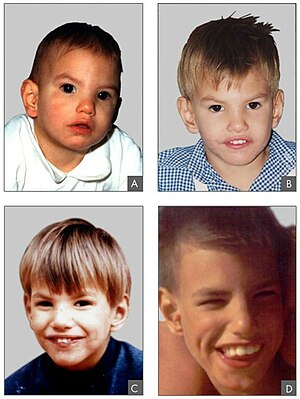Cri du chat syndrome
| Cri du chat, or Cri-du-chat | |
|---|---|
| Other names |
|
 | |
| Facial features of a person with Cri du chat syndrome at the age of 8 months (A), 2 years (B), 4 years (C) and 9 years (D) | |
| Specialty | Medical genetics |
Cri du chat syndrome (Cat's cry syndrome) is a medical condition that affects about 1 in 50,000 infants.
Infants with this illness have a difference. When they cry it sounds like a cat meowing or sometimes like a cat screaming. As the child gets older, this doesn't happen so much.
Cri du chat syndrome was first written about by Jerôme Lejeune, a French pediatrician in 1963, so it is sometimes called Lejeune syndrome.
The syndrome is caused by a bad copying of a gene, which leaves part of chromosome 5p missing about 90% of its material. The condition affects more girls than boys: of six cases on average about one is a boy. What is the effect? The name gives a clue. Children who have it have problems with the voice box. They usually have other disabilities as well: some have a learning disability or physical disability, and others have both of these.
The following symptoms are common:
- The head and skull are smaller than they would normally be.
- Low muscle tone, meaning that children may have problems feeding, swallowing and sucking.
- Teeth can be out of place, too close together or too far apart.
- Growth issues: even as adults, people with this syndrome are smaller than normal.
- Very poor motor skills, causing difficulty with movement, walking, holding eating utensils.
- The child's body will develop later than those of children without the condition.
- Ears and face often look different.
- A cognitive impairment / intellectual disability
Some of these problems mean that those who have this condition will almost certainly find life difficult. Only about half of children who have Cri du chat syndrome can eat with a spoon by the age of 3.5 years.[1]
This is a genetic disorder for which no treatment exists. Individual symptoms can be treated separately. The situation can be found before birth.
References[change | change source]
- ↑ Pentiuk, Scott. "Cri du Chat Syndrome". www.rarediseases.org. NORD (National Association for Rare Diseases. Retrieved 5 January 2022.
